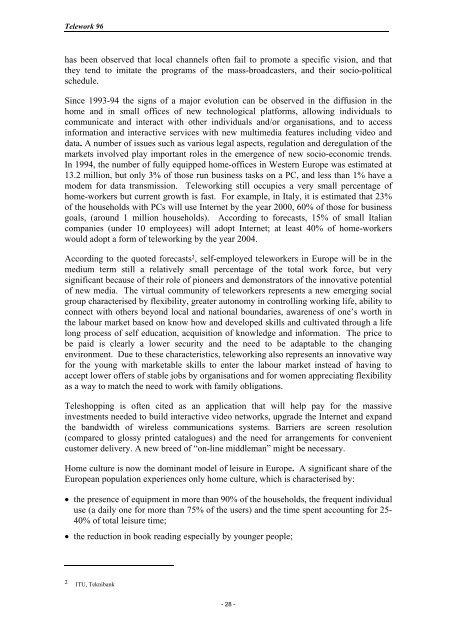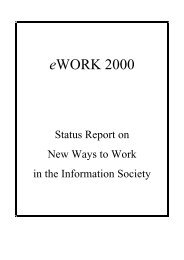1996 - European Telework Week
1996 - European Telework Week
1996 - European Telework Week
- No tags were found...
You also want an ePaper? Increase the reach of your titles
YUMPU automatically turns print PDFs into web optimized ePapers that Google loves.
<strong>Telework</strong> 96<br />
has been observed that local channels often fail to promote a specific vision, and that<br />
they tend to imitate the programs of the mass-broadcasters, and their socio-political<br />
schedule.<br />
Since 1993-94 the signs of a major evolution can be observed in the diffusion in the<br />
home and in small offices of new technological platforms, allowing individuals to<br />
communicate and interact with other individuals and/or organisations, and to access<br />
information and interactive services with new multimedia features including video and<br />
data. A number of issues such as various legal aspects, regulation and deregulation of the<br />
markets involved play important roles in the emergence of new socio-economic trends.<br />
In 1994, the number of fully equipped home-offices in Western Europe was estimated at<br />
13.2 million, but only 3% of those run business tasks on a PC, and less than 1% have a<br />
modem for data transmission. <strong>Telework</strong>ing still occupies a very small percentage of<br />
home-workers but current growth is fast. For example, in Italy, it is estimated that 23%<br />
of the households with PCs will use Internet by the year 2000, 60% of those for business<br />
goals, (around 1 million households). According to forecasts, 15% of small Italian<br />
companies (under 10 employees) will adopt Internet; at least 40% of home-workers<br />
would adopt a form of teleworking by the year 2004.<br />
According to the quoted forecasts 2 , self-employed teleworkers in Europe will be in the<br />
medium term still a relatively small percentage of the total work force, but very<br />
significant because of their role of pioneers and demonstrators of the innovative potential<br />
of new media. The virtual community of teleworkers represents a new emerging social<br />
group characterised by flexibility, greater autonomy in controlling working life, ability to<br />
connect with others beyond local and national boundaries, awareness of one’s worth in<br />
the labour market based on know how and developed skills and cultivated through a life<br />
long process of self education, acquisition of knowledge and information. The price to<br />
be paid is clearly a lower security and the need to be adaptable to the changing<br />
environment. Due to these characteristics, teleworking also represents an innovative way<br />
for the young with marketable skills to enter the labour market instead of having to<br />
accept lower offers of stable jobs by organisations and for women appreciating flexibility<br />
as a way to match the need to work with family obligations.<br />
Teleshopping is often cited as an application that will help pay for the massive<br />
investments needed to build interactive video networks, upgrade the Internet and expand<br />
the bandwidth of wireless communications systems. Barriers are screen resolution<br />
(compared to glossy printed catalogues) and the need for arrangements for convenient<br />
customer delivery. A new breed of “on-line middleman” might be necessary.<br />
Home culture is now the dominant model of leisure in Europe. A significant share of the<br />
<strong>European</strong> population experiences only home culture, which is characterised by:<br />
• the presence of equipment in more than 90% of the households, the frequent individual<br />
use (a daily one for more than 75% of the users) and the time spent accounting for 25-<br />
40% of total leisure time;<br />
• the reduction in book reading especially by younger people;<br />
2 ITU, Teknibank<br />
- 28 -








